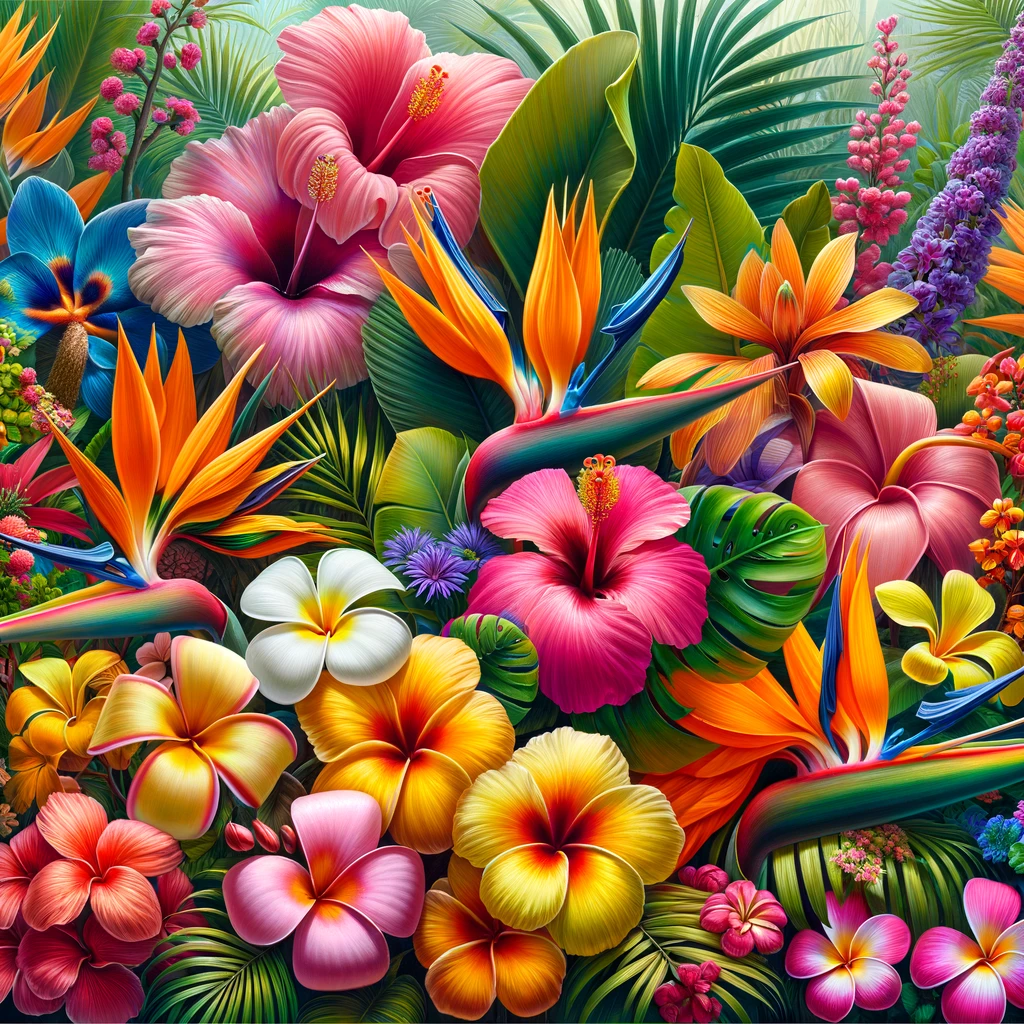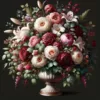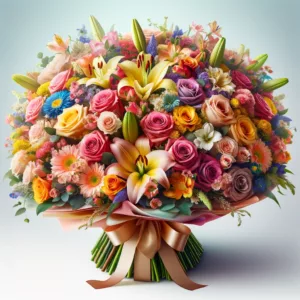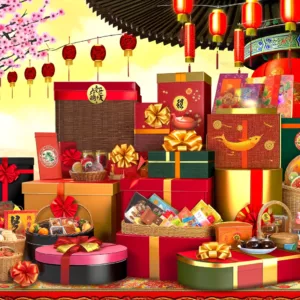Discover the enchanting world of What Are The Tropical Flowers? Dive into a vibrant realm where exotic blooms boast dazzling colors and unique shapes. Perfect for garden enthusiasts and floral aficionados seeking to explore or enhance their tropical gardens. Learn more about these natural beauties today.
Introduction
Tropical flowers, the flamboyant jewels of the plant kingdom, captivate the senses with their extraordinary colors, mesmerizing fragrances, and unique forms. Thriving in the warm, humid climates of the tropics, these flowers embody the essence of their lush, vibrant ecosystems. From the striking heliconias with their lobster-claw blooms to the delicate frangipani, whose sweet scent fills the evening air, tropical flowers are a diverse group that includes some of the most breathtaking species in the floral world.
Unlike their temperate counterparts, tropical flowers often exhibit an intense durability to thrive in the heat and humidity, showcasing nature’s adaptability. Their vivid colors, ranging from the deepest reds to the most luminous yellows, are not just a feast for the eyes but also play a crucial role in attracting pollinators. This introduction to tropical flowers opens the door to a world where the extraordinary becomes the norm, inviting gardeners, florists, and nature lovers to explore the rich biodiversity of the Earth’s equatorial regions.
What are the tropical flowers?
Tropical flowers are known for their vibrant colors, unique shapes, and ability to thrive in warm climates. They typically grow in tropical regions where the environment is humid and temperatures are consistently warm throughout the year. Here are some well-known tropical flowers:
- Hibiscus: A symbol of tropical beauty, hibiscus flowers come in many colors, including red, yellow, pink, and orange. They are large, showy flowers that can be found in many tropical regions.
- Bird of Paradise (Strelitzia): Known for its striking appearance, the Bird of Paradise flower resembles a bird in flight. It’s native to South Africa but is now common in many tropical areas.
- Orchids: Tropical orchids are among the largest families of flowering plants, with thousands of species. They are known for their intricate and often fragrant flowers.
- Plumeria: Also known as Frangipani, plumerias are tropical trees famous for their beautiful, fragrant flowers used in making traditional Hawaiian leis.
- Bougainvillea: A flowering vine that is known for its colorful and papery flowers, which are modified leaves called bracts.
- Heliconia: Also known as lobster-claws, heliconias are known for their vibrant, unusual-shaped flowers that attract hummingbirds.
- Ginger Flowers: Including varieties like Red Ginger and Torch Ginger, these flowers are not only beautiful but some are also edible.
- Anthurium: Known for its glossy, heart-shaped flowers, which are actually spathes, with a protruding spadix that can be various colors.
- Frangipani (Plumeria): Known for its sweet fragrance and waxy flowers, Frangipani is often found in tropical regions around the world.
- Passion Flower: Belonging to the Passiflora genus, these flowers are intricate and have a unique structure, often with a circle of filaments that resemble a crown.
Tropical flowers are not only important for their beauty but also play a vital role in the ecosystems where they grow, providing food and habitat for various species of insects, birds, and other wildlife.
Growing Tropical Flowers
Growing tropical flowers offers gardeners a unique opportunity to cultivate some of the world’s most vibrant and exotic plants, bringing a slice of paradise into their homes or gardens. Whether you’re aiming to create a lush, tropical landscape or simply add a pop of color to your indoor spaces, understanding the basics of tropical flower care is key to success. Here’s a guide to help you get started with growing tropical flowers.
Choose the Right Plants
Start by selecting tropical flowers that are well-suited to your climate and the specific conditions of your garden or home. If you live in a temperate area, look for tropical plants that can thrive indoors or in a greenhouse. Some popular and adaptable tropical flowers include Hibiscus, Orchids, Plumeria, and Bromeliads.
Understand the Climate Needs
Tropical flowers typically require warm temperatures and high humidity to thrive. If you’re growing them outdoors, ensure your climate can sustain these conditions year-round or during the growing season. For indoor plants, you might need to increase humidity with a humidifier or by placing a water tray near the plants.
Provide Adequate Light
Most tropical flowers need plenty of bright, indirect light to flourish. If growing indoors, place them near a window that receives ample sunlight but avoid direct sun exposure, which can scorch the leaves and petals. For outdoor gardens, choose a location that receives partial shade to protect the plants from the intense midday sun.
Watering and Feeding
Tropical plants generally prefer consistently moist soil but not waterlogged conditions. Ensure proper drainage in pots and beds to prevent root rot. Water the plants when the top inch of soil feels dry to the touch. Feeding them with a balanced, slow-release fertilizer during the growing season will support their growth and flowering.
Soil and Potting
Use a well-draining, rich potting mix designed for tropical plants. Adding organic matter like compost can improve soil structure and nutrient content, supporting healthier plant growth. For container-grown tropical flowers, ensure the pots have adequate drainage holes.

Pruning and Maintenance
Regularly pruning your tropical flowers can encourage bushier growth and more blooms. Remove dead or yellowing leaves and spent flowers to maintain the plant’s health and appearance. Be on the lookout for pests and diseases, which can be common in the warm, humid conditions that tropical plants love.
Acclimatization
If you’re moving plants outdoors for the summer or bringing them inside for the winter, do so gradually. Acclimatize them to prevent shock by gradually increasing their exposure to the new conditions over a week or two.
Challenges and Solutions
Growing tropical flowers can come with its set of challenges, such as managing pests, diseases, and the right environmental conditions. Regular monitoring, proper care, and preventive measures can help overcome these challenges, ensuring the health and vibrancy of your tropical flowers.
Growing tropical flowers is a rewarding endeavor that brings beauty and a touch of the exotic to your environment. With the right care, these stunning plants can thrive, offering a spectacular display of colors, shapes, and fragrances. Whether you’re an experienced gardener or new to the world of tropical flora, the key to success lies in understanding and meeting the specific needs of these magnificent plants.
The Role of Tropical Flowers in Culture and Society
Tropical flowers, with their vibrant colors and exotic appearances, play a significant role in various cultures and societies around the world. These flowers are not just admired for their beauty but are deeply embedded in the traditions, rituals, and daily lives of many communities. They symbolize a wide range of concepts, from love and hospitality to reverence and remembrance. Here’s an exploration of the role of tropical flowers in culture and society.
Symbolism and Significance
Each tropical flower carries its own unique symbolism and significance. For example, the Hibiscus, particularly the red one, is often associated with love and passion and is the national flower of Malaysia and South Korea, symbolizing the delicate beauty of nature. In Hawaii, the Plumeria is used in leis and represents hospitality, warmth, and welcoming. The Orchid, found in numerous varieties across the tropics, symbolizes luxury, beauty, and strength in many cultures and is highly prized for its intricate blooms.
Religious and Spiritual Uses
Tropical flowers are often used in religious and spiritual ceremonies across the world. In Hinduism, flowers like the Lotus are considered sacred and symbolize purity and enlightenment, frequently used in rituals and offerings to gods. Similarly, in Buddhism, certain flowers are used to represent the fleeting nature of life, serving as reminders of the impermanence of physical existence.
Festivals and Celebrations
Many tropical countries have festivals and celebrations where tropical flowers play a central role. In India, the festival of Onam is marked by the creation of Pookalam, floral designs made on the ground. In Thailand, the festival of Loi Krathong involves floating baskets decorated with flowers down rivers. These festivals use flowers not just for decoration but as a way to celebrate and respect nature’s beauty and bounty.
Economic Impact
The cultivation and trade of tropical flowers have a significant economic impact on many tropical countries. The global demand for exotic flowers for bouquets, weddings, and events has led to a thriving export industry. Countries like Colombia, Ecuador, and Kenya are major exporters of tropical flowers, providing employment and supporting local economies.
Art and Literature
Tropical flowers have long been a source of inspiration in art and literature, symbolizing exotic beauty and the mysteries of the tropics. Artists and writers have used the imagery of flowers like the Bird of Paradise and the Orchid to convey messages of love, beauty, and transcendence. The vivid colors and unique shapes of tropical flowers make them a popular subject in paintings, sculptures, and literary descriptions.
Personal and Social Identity
In many cultures, tropical flowers are a part of personal and social identity. For instance, wearing a flower behind one’s ear in Hawaii can signify relationship status. In Tahiti, flowers are used in traditional dress and dance, playing a crucial role in cultural expressions and identity.
Conservation and Environmental Awareness
The beauty and uniqueness of tropical flowers also highlight the importance of conservation and environmental awareness. Many tropical flowers are endangered due to habitat loss and climate change. Their role in culture and society emphasizes the need to protect these natural treasures and the ecosystems they inhabit.
DIY Tropical flowers bouquet
Creating a DIY tropical flowers bouquet is an exciting way to bring the vibrant and exotic beauty of the tropics into your home or to share as a thoughtful, handmade gift. Tropical flowers, with their bright colors and unique shapes, can make any bouquet stand out. Here’s a step-by-step guide to assembling your own tropical flower bouquet.
Materials Needed:
- A selection of tropical flowers (such as Hibiscus, Bird of Paradise, Orchids, Heliconia, and Plumeria)
- Foliage and greenery for added texture and volume (like Monstera leaves or ferns)
- Floral scissors or a sharp knife
- Floral tape
- Floral wire (for supporting weaker stems or securing elements)
- A bouquet wrap (like burlap, ribbon, or decorative paper)
- A clear vase or container (if you’re planning to display it)
Step 1: Selection of Flowers
Choose a variety of tropical flowers that offer a range of colors, sizes, and shapes. Incorporating different textures and lengths can add depth and interest to your bouquet. Consider the overall color scheme and how the colors complement each other.
Step 2: Prepare Your Flowers
- Trim the stems: Cut the stems at a 45-degree angle under running water to allow for better water absorption.
- Remove excess leaves: Strip away any leaves that might sit below the waterline to prevent bacterial growth.
- Hydrate flowers: Allow the flowers to hydrate by placing them in water for a few hours before assembling your bouquet. This step is crucial for tropical flowers to look their best.
Step 3: Create a Base with Foliage
Start your bouquet by creating a loose base with your chosen foliage. This base will support your flowers and add volume to the bouquet. Arrange the greenery in a circular shape, which will be the foundation for your floral design.
Step 4: Add the Largest Flowers First
Begin adding your larger tropical flowers to the base of greenery. Place these strategically around the bouquet to balance the arrangement. These flowers will be the focal points, so consider their placement carefully.
Step 5: Incorporate Smaller Flowers and Fillers
After setting your main flowers, start filling in the gaps with smaller blooms and filler flowers. These can add contrast, texture, and depth to your bouquet. Ensure even distribution so the bouquet looks balanced from all angles.
Step 6: Secure the Bouquet
Once you’re satisfied with your arrangement, use floral tape to secure the stems together. Wrap the tape tightly around the stems several times to ensure the bouquet holds its shape. If any flowers have weak stems, use floral wire to provide additional support.
Step 7: Wrap the Bouquet
Choose a bouquet wrap that complements the colors in your arrangement. Wrap the base of the stems, covering the floral tape. You can use burlap for a rustic look, satin ribbon for a more elegant feel, or any decorative paper that matches your style. Secure the wrap with pins or a decorative ribbon.
Step 8: Trim the Stems
Once your bouquet is wrapped, give the stems one final trim so they’re all the same length. This step is especially important if you’ll be placing the bouquet in a vase.
Step 9: Hydrate and Display
Place your finished tropical bouquet in a vase filled with fresh water. Keep the bouquet in a cool, shaded area away from direct sunlight to prolong the life of the flowers.
FAQ’s
Tropical flowers originate from regions near the equator, known for their warm and humid climates. Although these conditions are ideal for their growth, many tropical flowers can also adapt well to indoor environments or greenhouses.
Roses flourish in tropical climates, thriving on the warmth. However, the high humidity can make them susceptible to fungal diseases. To ensure roses remain healthy and vibrant in tropical environments, choosing varieties known for their robust disease resistance is crucial.
Sunflowers are typically grown in climates ranging from cool temperate to warm subtropical areas. They can also thrive in drier tropical regions, although humid conditions are not conducive to their growth.
The majority of these species originate from the Northern Hemisphere, thriving in temperate climates and reaching into subtropical areas. Numerous plants carry “lily” in their common names; however, they are not part of the same genus, making them distinct from true lilies.
Conclusion
Tropical flowers represent a diverse and vibrant group of plants that thrive in the warm, humid environments close to the equator. From the striking beauty of the Hibiscus and the exotic allure of the Bird of Paradise to the delicate elegance of Orchids and the vivid displays of Bougainvillea, these flowers bring a touch of the exotic to landscapes and gardens worldwide.
Not only do they offer aesthetic appeal with their bold colors and unique forms, but they also play significant roles in their native habitats, supporting ecosystems and cultural traditions. Whether grown in their natural tropical settings or cultivated in greenhouses and homes around the globe, tropical flowers continue to captivate and enchant with their extraordinary beauty and variety.







